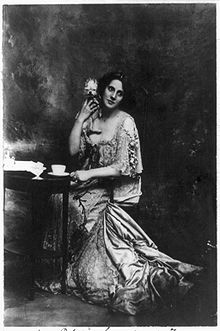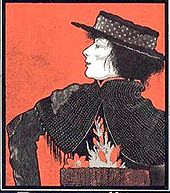- Mrs. Patrick Campbell
-
For other people named Patrick Campbell, see Patrick Campbell (disambiguation).
Mrs Patrick Campbell 
Born Beatrice Stella Tanner
9 February 1865
Kensington, London, EnglandDied 9 April 1940 (aged 75)
Pau, FranceOther names "Mrs. Pat" Occupation Actress Years active 1888-1935 Mrs Patrick Campbell (9 February 1865 – 9 April 1940) was a British stage actress.
Contents
Early life and marriages
Campbell was born Beatrice Stella Tanner in Kensington, London, to John Tanner and Maria Luigia Giovanna, daughter of Count Angelo Romanini. She studied for a short time at the Guildhall School of Music.
Her first marriage, from which she took the name by which she is generally known, produced two children, Alan Urquhart ('Beo') and Stella, and ended with the death of her first husband in the Boer War in 1900.
Fourteen years later, Campbell became the second wife of George Cornwallis-West, a dashing writer and soldier previously married to Jennie Jerome, the mother of Sir Winston Churchill.
Stage career
Already well-known as an amateur, Campbell made her professional stage debut in 1888 at the Alexandra Theatre, Liverpool, four years after her marriage to Patrick Campbell. In March, 1890, she appeared in London at the Adelphi, where she afterward played again in 1891–93. She became successful as a result of starring in Sir Arthur Wing Pinero's play, The Second Mrs Tanqueray, in 1893, at St. James's Theatre where she also appeared in 1894 in The Masqueraders. As Kate Cloud in John-a-Dreams, produced by Beerbohm Tree at the Haymarket in 1894, she made another success, and again as Agnes in The Notorious Mrs. Ebbsmith at the Garrick (1895).
Among her other performances were those in Fédora (1895), Little Eyolf (1896), and her notable performances with Forbes-Robertson at the Lyceum in the rôles of Juliet in Romeo and Juliet, Ophelia in Hamlet, and Lady Macbeth (1895–98) in "Macbeth".
Once established as a major star, Campbell also assisted in the early careers of some noted actors, such as Gerald Du Maurier and George Arliss.[1]
In 1900, Mrs. Pat, having become her own Manager/Director, made her debut performance on Broadway in New York City in Magda, a marked success. Subsequent appearances in New York and on tour in the United States established her as a major theatrical presence in America. Campbell would regularly perform on the New York stage until 1933.
Further noteworthy performances included The Joy of Living (1902), as Melisande to the Pelleas of her close friend Sarah Bernhardt in Pelléas et Mélisande (1904), Hedda Gabler (1907), Electra (1908), The Thunderbolt (1908), Lady Patricia (1911) and Bella Donna (1911) Despite her second marriage, to George Cornwallis-West, she continued to use the stage name "Mrs Patrick Campbell".
In 1914, Mrs Pat played Eliza Doolittle in the original West End production of Pygmalion which George Bernard Shaw had expressly written for her.[2][3] Although forty-nine when she originated the role opposite the Henry Higgins of Sir Herbert Beerbohm Tree, she triumphed as the young flower girl and took the play to New York and on tour in 1915. She successfully played Eliza again in a 1920 London revival of the play.[4][5]
A couple of Campbell's later significant performances were as the title role in the 1922 West End production of Henrik Ibsen's play Hedda Gabler[6] and Mrs. Alving in the 1928 "Ibsen Centennial" staging of the play Ghosts (with John Gielgud performing as her son Oswald).[7]
Mrs Pat's last major stage role was in the Broadway production of Ivor Novello's play A Party where she portrayed the cigar-smoking, pekinese wielding actress "Mrs. MacDonald" - a clear takeoff on her own well known persona - and made off with the best reviews.[8]
In her later years, Campbell made notable appearances in motion pictures, including One More River (1934), Riptide (1934), and Crime and Punishment (1935).
Mrs Pat's impolitic behavior in Hollywood and her tendency to reject roles that could have vitally helped her career in later years caused Alexander Woollcott to declare that "...she was like a sinking ship firing on the rescuers".[9]
Relationship with George Bernard Shaw
In the late 1890s Campbell first became aware of George Bernard Shaw - the famous and feared dramatic critic for "The Saturday Review" - who lavishly praised her better performances and thoroughly criticized her lesser efforts. Shaw had already used her as inspiration for some of his plays before their first meeting in 1897 when he unsuccessfully tried to persuade Mrs Pat to play the role of Judith Anderson in the first production of his play The Devil's Disciple.[10] But it was not until 1912 when they began negotiations for the London production of Pygmalion that Shaw developed the infatuation for Mrs. Pat that resulted in a passionate, yet unconsummated, love affair of mutual fascination and a legendary exchange of letters.[11] It was Campbell who broke off the relationship [12] even though Shaw was about to direct her in Pygmalion. While they remained friends in spite of the break and her subsequent marriage to George Cornwallis-West, George Bernard Shaw never again allowed Mrs. Pat to originate any of the roles he had written with her in mind (e.g. Hesione Hushabye (Heartbreak House), the Serpent (Back to Methuselah), etc.,) and was thought by many to be using his play The Apple Cart and the character of King Magnus' platonic mistress Orinthia to air his personal disappointment in their relationship.[13]
In later years, Shaw refused to allow the impoverished Campbell to publish or sell any of their letters except in heavily edited form, for fear of upsetting his wife Charlotte Payne-Townshend and the possible harm that the letters might cause to his public image.[14] Most of the letters were not published until 1952, two years after Shaw's death.
When Anthony Asquith was preparing to produce the 1938 film of Pygmalion, Shaw suggested Mrs Pat for the role of Mrs Higgins. She declined.[15]
Famous quote
Campbell was infamous for her sharp wit. Her most well known remark, uttered upon hearing about an indiscreet relationship, was "My dear, I don't care what they do, so long as they don't do it in the street and frighten the horses" [16]
Death
She died on 9 April 1940 in Pau, France, aged 75.[17] Her death was one of the few deaths of a personal nature that George Bernard Shaw ever noted in his personal diaries.[18]
Legacy
A note book belonging to Campbell is housed at the University of Birmingham Special Collections department.
See also
- My Life And Some Letters by Mrs Patrick Campbell.
- Walkley, Drama and Life (London, 1907)
- Shaw, Dramatic Opinions (London, 1907)
- Archer, The Theatrical World (London, 1897)
- Mrs. Pat: The Life of Mrs. Patrick Campbell by Margot Peters (New York, 1984)
- The Truth About Pygmalion by Richard Huggett (Random House, 1969)
- Bernard Shaw and Mrs. Patrick Campbell: Their Correspondence edited by Alan Dent (Alfred A Knopf, 1952)
- This article incorporates text from an edition of the New International Encyclopedia that is in the public domain.
References
- ^ Mrs. Pat: The Life of Mrs. Patrick Campbell by Margot Peters, 1984 Alfred A. Knopf pp. 179 - 181, 183
- ^ The Truth About Pygmalion by Richard Huggett, 1969 Random House, pp. 20 - 27
- ^ Mrs. Pat: The Life of Mrs. Patrick Campbell by Margot Peters, 1984 Alfred A. Knopf p. 307
- ^ The Truth About Pygmalion by Richard Huggett, 1969 Random House, pp. 183 - 187
- ^ Mrs. Pat: The Life of Mrs. Patrick Campbell by Margot Peters, 1984 Alfred A. Knopf pp. 364 - 367
- ^ Mrs. Pat: The Life of Mrs. Patrick Campbell by Margot Peters, 1984 Alfred A. Knopf pp 379 - 382
- ^ Mrs. Pat: The Life of Mrs. Patrick Campbell by Margot Peters, 1984 Alfred A. Knopf pp 397 - 398
- ^ Mrs. Pat: The Life of Mrs. Patrick Campbell by Margot Peters, 1984 Alfred A. Knopf pp. 422 - 423
- ^ Mrs. Pat: The Life of Mrs. Patrick Campbell by Margot Peters, 1984 Alfred A. Knopf pp. 424 - 425
- ^ Mrs. Pat: The Life of Mrs. Patrick Campbell by Margot Peters, 1984 Alfred A. Knopf pp. 139 - 140
- ^ Bernard Shaw and Mrs. Patrick Campbell: Their Correspondence edited by Alan Dent, 1952 Alfred A Knopf
- ^ Mrs. Pat: The Life of Mrs. Patrick Campbell by Margot Peters, 1984 Alfred A. Knopf pp. 330 - 333
- ^ Mrs. Pat: The Life of Mrs. Patrick Campbell by Margot Peters, 1984 Alfred A. Knopf pp. 404 - 407
- ^ Mrs. Pat: The Life of Mrs. Patrick Campbell by Margot Peters, 1984 Alfred A. Knopf pp. 369 - 378
- ^ The Truth About Pygmalion by Richard Huggett, 1969 Random House, pp. 2 - 3
- ^ Mrs. Patrick Campbell by Alan Dent, 1961 p. 78
- ^ "Mrs. Campbell, 75, Famous Actress". New York Times. 11 April 1940. http://select.nytimes.com/gst/abstract.html?res=FA0E1FF93E54117A93C3A8178FD85F448485F9. Retrieved 29 June 2008. "Mrs. Patrick Campbell, famous actress, died last night in Pau, according to word received here to day. She had taken leading roles in plays of Shakespeare, Shaw and Barrie, and on several occasions had toured America."
- ^ Mrs. Pat: The Life of Mrs. Patrick Campbell by Margot Peters, 1984 Alfred A. Knopf p. 462
External links
- Mrs. Patrick Campbell at the Internet Broadway Database
- Mrs. Patrick Campbell at the Internet Movie Database
- Archival material relating to Mrs. Patrick Campbell listed at the UK National Register of Archives
- Mrs Patrick Campbell photo gallery at NYP Library
- Mrs. Patrick Campbell collection at University of Victoria, Special Collections
- Mrs Patrick Campbell in Pygmalion 1915
- Mrs. Patrick Campbell University of Washington, Sayre collection
Categories:- 1865 births
- 1940 deaths
- Actors from London
- English film actors
- English stage actors
- Vaudeville performers
- Disease-related deaths in France
- People from Kensington
Wikimedia Foundation. 2010.


